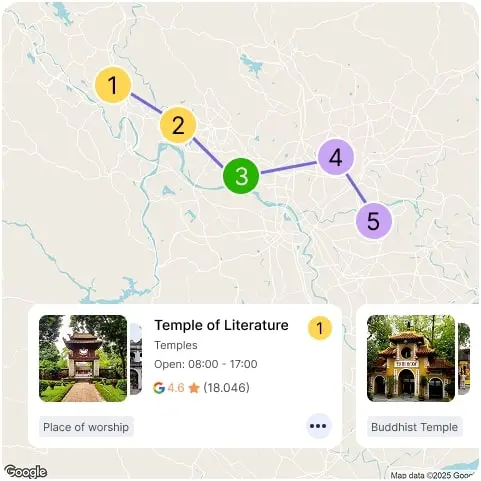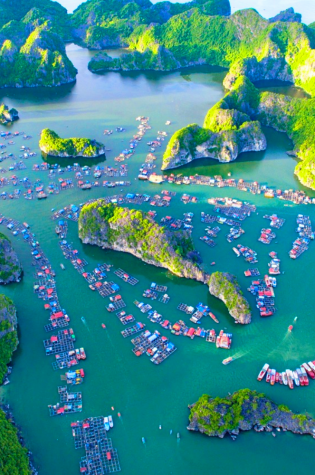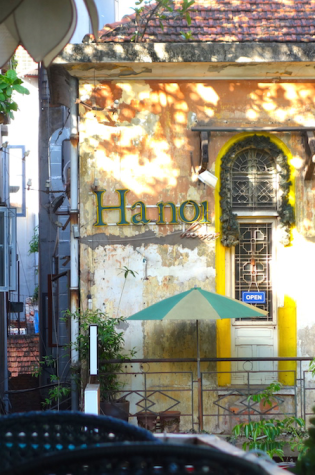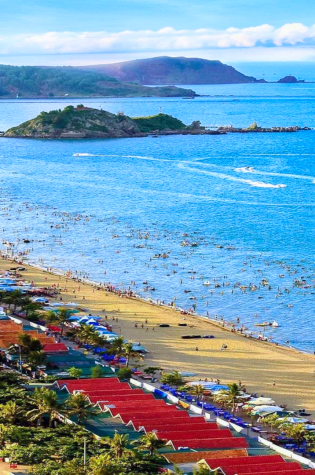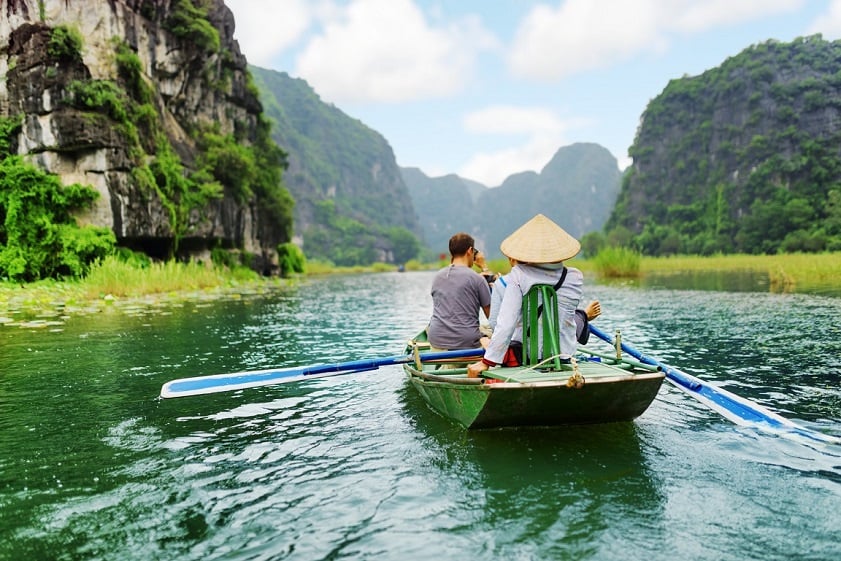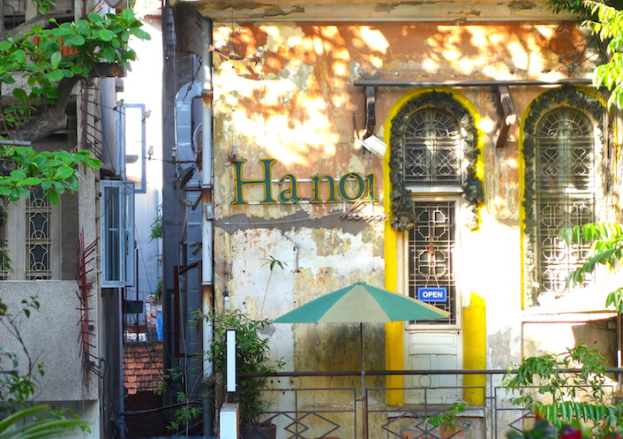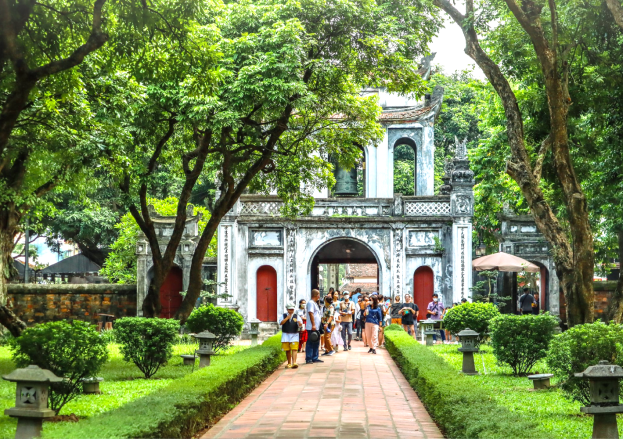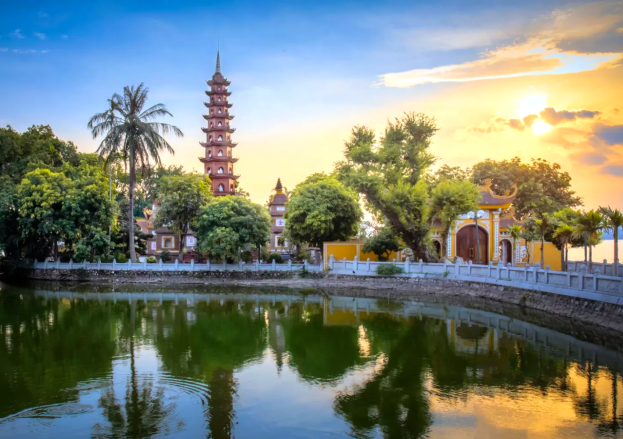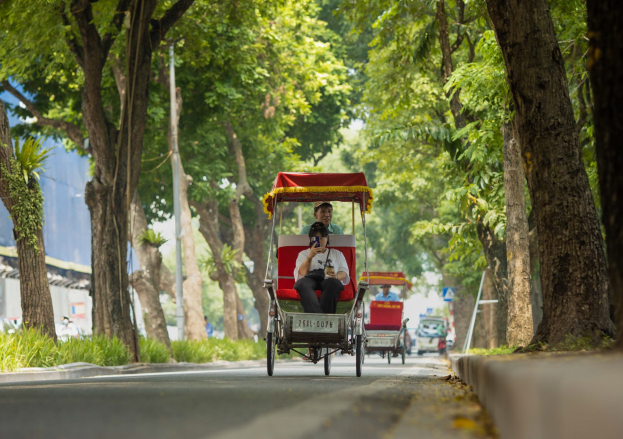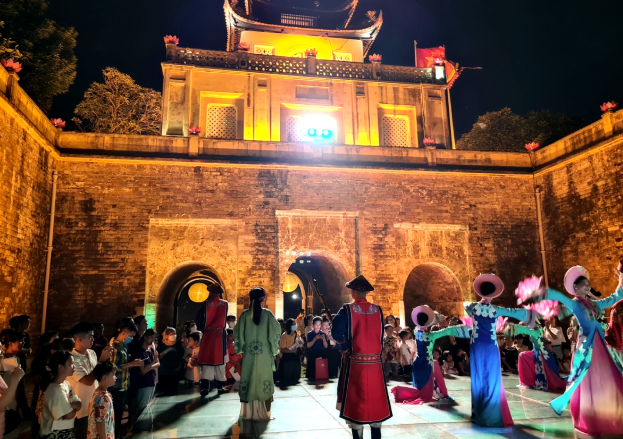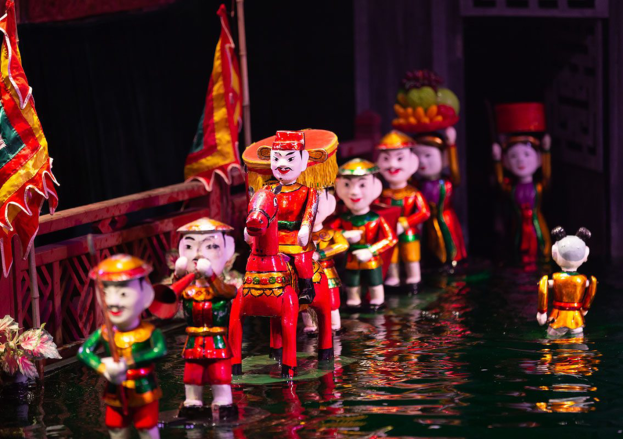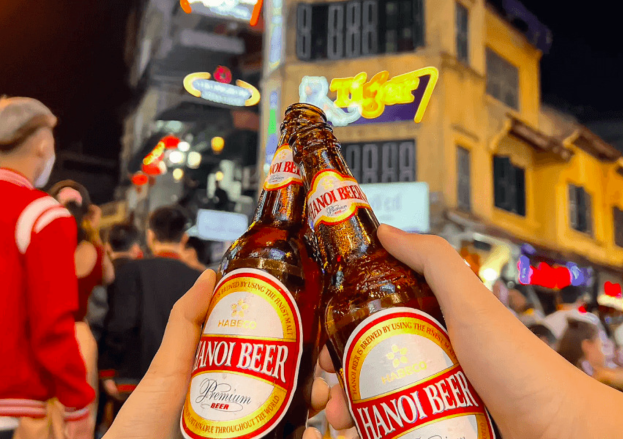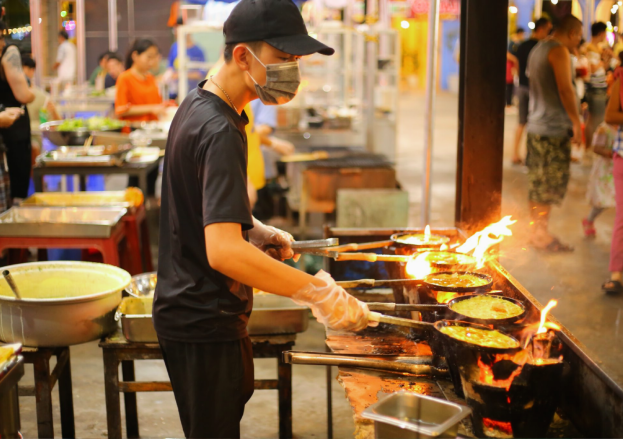
Mountain Getaways
Escape to Vietnam’s majestic mountains, where misty peaks, lush forests, and tranquil valleys await. Discover serene landscapes, vibrant local cultures, and unforgettable adventures in the heart of the highlands.

Embark on the trekking route to Ngoc Linh – the Roof of Kon Tum
06 Sep, 2025
Conquering Challenges in the Great Forest Trekking to the summit of Ngoc Linh is not for the faint-hearted. Rising to more than 2,598 meters, the path demands determination, endurance, and a spirit of adventure. Trails snake steeply upward, often muddy and slippery after rains, with sections of rugged terrain where trekkers must cling to roots and rocks for support. At times, the journey feels exhausting—but it is precisely this sense of challenge that makes every step meaningful. Each stage of the trek reveals a new face of the mountain. The lower slopes are filled with terraced fields and scattered ethnic villages, where farmers tend their crops under the morning sun. Deeper into the forest, the landscape shifts into towering trees, thick canopies, and cool mountain air scented with wild orchids and forest herbs. Hidden waterfalls tumble into clear streams, creating natural resting points where trekkers can refresh and reflect. And as the trail climbs higher, clouds roll in, wrapping the mountain in shifting veils of mist that make the world feel dreamlike and otherworldly. At the summit, the reward is more than a view—it is the feeling of standing at the edge of the sky. The panorama stretches endlessly: layers of green ridges fading into the horizon, valleys blanketed with white clouds, and the Central Highlands opening below like a vast, untouched canvas. Few experiences compare to watching the sunrise here, as the first light spills across the peaks, painting the mountain in shades of gold and pink. Ngoc Linh – A Cradle of Culture and Tradition Ngoc Linh is not just a mountain; it is a sacred symbol in the lives of local ethnic communities such as the Xê Đăng and Ba Na. For generations, they have revered it as a guardian spirit, tied closely to their myths, rituals, and identity. Trekking through the region offers more than natural beauty—it opens a door to centuries-old traditions still thriving in these highlands. On the way, trekkers may stop at stilt-house villages, where the warmth of local hospitality shines through simple but genuine gestures: a smile, a shared meal, or a cup of corn wine offered by the fire. Visitors can witness age-old crafts, such as weaving and wood carving, or hear traditional songs that echo the rhythm of life in the mountains. These encounters leave lasting impressions, reminding travelers that Ngoc Linh is as much about people as it is about peaks. Adding to its cultural richness, Ngoc Linh is also home to the legendary Ngoc Linh ginseng, Vietnam’s most precious medicinal plant. Known as a “national treasure,” this rare ginseng thrives only in the high-altitude forests here. Visiting the carefully protected ginseng gardens along the trek not only enriches the journey but also reveals the deep connection between nature and human livelihood in this remote corner of the Central Highlands. A Trekking Journey Full of Experiences Trekking Ngoc Linh can be tailored to different levels of adventure. Most journeys range from 2 days 1 night to 3 days 2 nights, with routes often starting in Kon Tum Kơ Tu village or the Măng Ri commune of Tu Mơ Rông district. Trekkers cross bamboo bridges over streams, climb steep jungle trails, and set up camp in the heart of the forest. Nights are spent either under the stars or in rustic village homestays, where travelers gather around fire pits, sharing stories and enjoying traditional dishes cooked from local ingredients. This is not just a physical challenge but also a journey of camaraderie and personal growth. The moments of pushing through steep ascents, preparing a simple forest meal with your trekking team, or standing side by side to watch the dawn unfold on the “roof of Kon Tum” forge memories that endure long after the hike ends. For many, the trek becomes a symbol of resilience, reminding them of their own strength and connection to nature. Tips for Trekking Ngoc Linh Best time to visit: From December to April, when the weather is dry, skies are clearer, and trails are safer. The rainy season can make paths dangerously slippery. Physical preparation: The trek is demanding, so build endurance with hiking, running, or stair training beforehand. Good stamina makes the experience more enjoyable. Essential gear: Quality trekking shoes with strong grip, warm layered clothing for chilly nights, rain protection, a tent and sleeping bag for camping, personal first-aid supplies, and sufficient water. Don’t forget insect repellent for forest areas. Local guide: Always trek with a local guide. They not only ensure safety and navigation but also share cultural insights, legends of Ngoc Linh, and access to places off the beaten path. Exploring the trekking route to Ngoc Linh is more than a mountain climb—it is a profound journey into the wilderness and culture of Vietnam’s Central Highlands. It challenges your body, strengthens your spirit, and connects you with both nature’s grandeur and the traditions of the people who call these mountains home. For those seeking an adventure that is both physically rewarding and deeply meaningful, Ngoc Linh stands tall as a peak worth conquering and remembering forever.
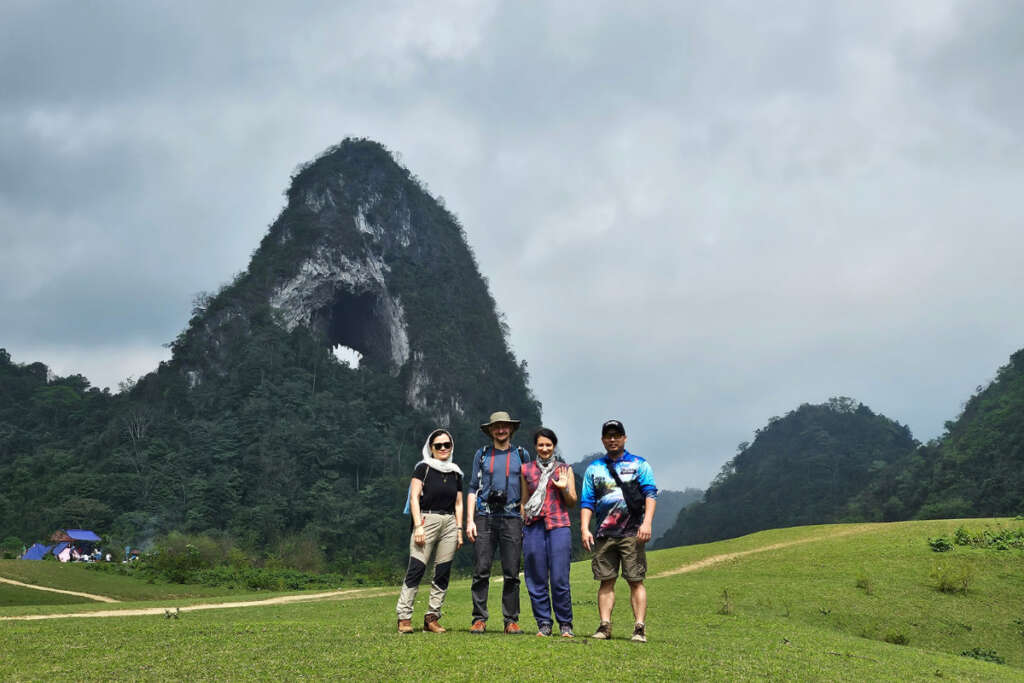
Venture into the untouched trekking paths of Cao Bang Province
06 Sep, 2025
A Land of Dramatic Scenery The first thing that strikes visitors about Cao Bang is its breathtaking scenery. Trekking paths wind through lush valleys, rolling limestone mountains, and serene rivers, painting a picture of Vietnam’s unspoiled wilderness. Along the way, trekkers often pass by rice terraces that shimmer in different shades depending on the season—bright green in summer, golden yellow during harvest, and misty gray in winter. The landscapes feel untouched by mass tourism, making every step an invitation to slow down and immerse yourself in nature. One of the highlights of trekking in Cao Bang is reaching Ban Gioc Waterfall, one of the largest and most beautiful waterfalls in Southeast Asia. Surrounded by dense forests and towering cliffs, the waterfall cascades dramatically over multiple tiers, creating a breathtaking backdrop that feels almost otherworldly. For trekkers, the journey to Ban Gioc is as rewarding as the destination itself, as it passes through winding trails and peaceful villages. Cultural Encounters Along the Trails Cao Bang is not only about nature—it is also home to diverse ethnic minority communities, including the Tay, Nung, H’Mong, and Dao people. Trekking through the province often means encountering daily life in traditional stilt houses, hearing folk songs, or even sharing a cup of corn wine with locals. Many villages welcome travelers for homestay experiences, where you can taste homemade dishes, learn about traditional crafts, and listen to stories passed down through generations. These cultural exchanges add depth to the trekking journey, making it more than just a physical adventure. Unlike Sapa or Ha Giang, where trekking routes are now bustling with tourists, Cao Bang’s trails remain quiet and tranquil. This sense of untouched beauty appeals to those who seek solitude and authenticity. The paths vary in difficulty, from gentle walks along riversides to more challenging hikes through mountain passes, giving both casual travelers and seasoned trekkers plenty of options. Along the way, you’ll likely encounter more buffaloes and farmers than fellow tourists, reinforcing the sense of stepping into a world apart. What makes Cao Bang’s trekking unique is its quiet and unspoiled atmosphere. While popular destinations like Ha Giang and Sapa now see heavy tourist traffic, Cao Bang’s routes remain tranquil. Trekkers often find themselves alone with nature, sharing the trail with grazing buffaloes or farmers carrying bamboo baskets rather than crowds of tourists. The diversity of trekking routes caters to different preferences: Short treks (2–3 hours): Perfect for beginners, these trails wind through valleys and riversides, often leading to caves or small waterfalls. Moderate treks (half-day to full-day): These routes involve more elevation, taking hikers across forested hills or terraced mountainsides. Multi-day treks: For the adventurous, Cao Bang offers extended journeys connecting Ban Gioc, Pac Bo (where President Ho Chi Minh once lived), and remote ethnic villages. These treks provide a deep dive into both nature and history. Practical Tips for Trekking in Cao Bang Best time to visit: The ideal trekking seasons are from September to November and March to May, when the weather is cool and pleasant. Autumn is especially beautiful with golden rice fields and clear skies. What to pack: Comfortable hiking shoes are essential, as trails can be rocky and slippery. Bring a light jacket, rain protection, sunscreen, and plenty of water. Hiring a guide: A local guide can not only help you navigate lesser-known paths but also introduce you to villages and explain the cultural significance of the region. Homestay experience: Don’t miss the chance to spend a night in a traditional homestay, which offers both comfort and a deeper understanding of local life. Exploring the untouched trekking paths of Cao Bang Province is more than just an outdoor adventure—it is a journey into the heart of Vietnam’s natural and cultural heritage. With its unspoiled landscapes, welcoming communities, and serene atmosphere, Cao Bang offers a rare escape from crowded tourist spots. For those in search of authenticity, tranquility, and unforgettable scenery, trekking in Cao Bang promises memories that will last a lifetime.
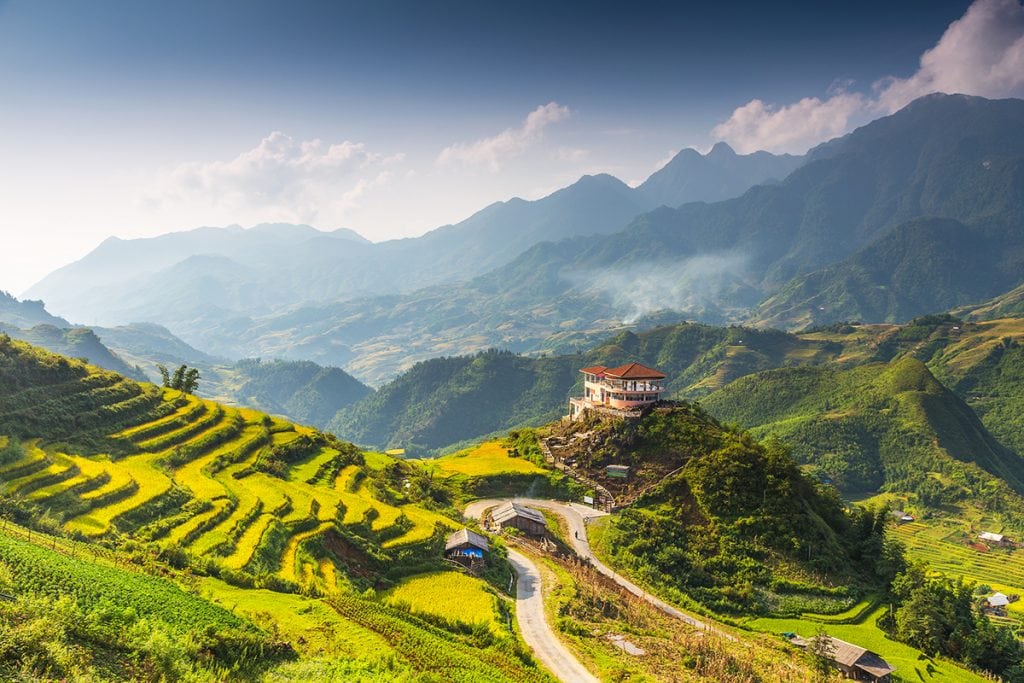
Exploring Muong Hoa Valley and hidden trails in Sapa
06 Sep, 2025
Sapa, a charming mountain town in Northern Vietnam, is world-renowned for its terraced rice fields, misty landscapes, and rich cultural heritage. Among its many treasures, Muong Hoa Valley stands out as one of the most breathtaking and rewarding destinations for hikers and adventure seekers. Beyond its scenic beauty, the valley offers a chance to discover hidden trails, encounter ethnic minority villages, and immerse yourself in authentic mountain life. About Muong Hoa Valley Located about 10 kilometers southeast of Sapa town, Muong Hoa Valley stretches along the Hoang Lien Son mountain range. It is home to some of the most spectacular terraced rice fields in the world, recognized by National Geographic and other international publications. The valley is inhabited by several ethnic groups such as the H’Mong, Dao, Tay, and Giay, whose traditional lifestyle, customs, and houses add cultural depth to the natural beauty. The valley is especially mesmerizing during the rice season: Spring (March – May): lush green fields and blooming wildflowers. Summer (June – August): rice fields turn a deep green, full of life. Autumn (September – October): golden terraced fields at harvest time, the most photogenic season. Winter (November – January): misty mornings and peaceful atmosphere, with occasional snowfall in the mountains. Aside from the rice terraces, Muong Hoa also features a stone field with mysterious ancient carvings, believed to date back thousands of years. These engravings remain an archaeological enigma and are a fascinating stop for travelers. Hidden Hiking and Trekking Trails One of the most rewarding ways to discover the beauty of Muong Hoa Valley is through trekking. The valley offers a variety of trails that suit different levels of hikers, from beginners to experienced adventurers. Each route unveils a different side of Sapa’s natural beauty and cultural richness, making trekking here a truly unforgettable journey. Sapa – Lao Chai – Ta Van Trail This is the most popular trekking route in Muong Hoa Valley, perfect for those who want to experience both nature and local culture. Starting from Sapa town, the trail winds down into the valley, revealing endless rice terraces cascading down the mountainsides. Along the way, you’ll pass through Lao Chai Village, home to the H’Mong people, and continue on to Ta Van Village, where the Giay community resides. Travelers can interact with local families, observe daily life, and enjoy the contrast between traditional wooden houses and the golden rice fields. The trek is not too difficult, making it ideal for families or first-time visitors. Giang Ta Chai Trail For those seeking a bit more adventure, the Giang Ta Chai trail provides a moderate challenge. The route takes you deeper into bamboo forests and across suspension bridges over clear mountain streams. A highlight of this trek is the chance to see stunning waterfalls hidden within the forest, offering perfect spots to rest and enjoy the scenery. Eventually, the path leads to Giang Ta Chai Village, inhabited by the Red Dao ethnic group, known for their distinctive embroidered costumes and herbal baths. Trekking here combines natural exploration with cultural immersion, making it a favorite among adventurous travelers. Su Pan Trail The Su Pan trail is less frequented by tourists, offering a more serene and authentic trekking experience. This path climbs gently up the valley, opening to panoramic views of Muong Hoa’s rice terraces stretching endlessly into the distance. Su Pan Village itself remains relatively untouched, with simple wooden houses, grazing buffalo, and locals working in the fields. It’s a place where travelers can enjoy peace, quiet, and meaningful interactions with villagers who rarely see large crowds of visitors. For those who prefer off-the-beaten-path adventures, this trail is an excellent choice. No matter which trail you choose, trekking in Muong Hoa Valley is more than just about landscapes—it’s also a journey into the heart of Sapa’s ethnic communities. Along the routes, you’ll find homestays where you can rest, enjoy traditional meals such as sticky rice, grilled pork, and corn wine, and listen to stories from your hosts. These experiences give travelers a deeper understanding of local traditions and provide a warm, personal connection that enhances the trekking adventure. Cultural Encounters What sets trekking in Muong Hoa Valley apart is not only the breathtaking scenery but also the opportunity to engage with the valley’s vibrant cultural life. Home to several ethnic minority groups such as the H’Mong, Dao, and Giay, the valley offers travelers a glimpse into traditions that have been carefully preserved for generations. As you make your way along the trails, you may encounter women skillfully weaving colorful brocades on traditional looms, a craft that reflects both artistry and heritage. Children can often be seen laughing and playing freely near the rice paddies, their lives intertwined with the rhythms of the land. Families work together on terraced farms, nurturing rice and corn crops that sustain both their livelihoods and their cultural identity. Choosing to stay overnight in a homestay enriches the experience even further. Local hosts welcome travelers warmly, often preparing home-cooked meals using ingredients from their own gardens and fields. Around the family hearth, you may hear stories passed down through generations, or learn about rituals, festivals, and customs that shape daily life in the valley. These intimate encounters transform a simple trek into a meaningful cultural journey, where travelers not only admire the beauty of the landscape but also connect deeply with the people who call it home. Tips for Trekking in Muong Hoa Valley The best time to visit is from September to early October during the harvest season. Wear comfortable shoes suitable for muddy and uneven trails. Bring water, sunscreen, and a light jacket as the weather can change quickly. Hire a local guide to enrich your journey with stories and cultural insights. Exploring Muong Hoa Valley and its hidden trails is more than just a hike—it’s a journey into the heart of Sapa’s culture and nature. From breathtaking rice terraces to authentic encounters with ethnic communities, every step in the valley reveals a new perspective of Northern Vietnam’s mountain beauty. Whether you are a photography lover, an adventure enthusiast, or simply someone seeking peace in nature, Muong Hoa Valley promises an unforgettable experience.
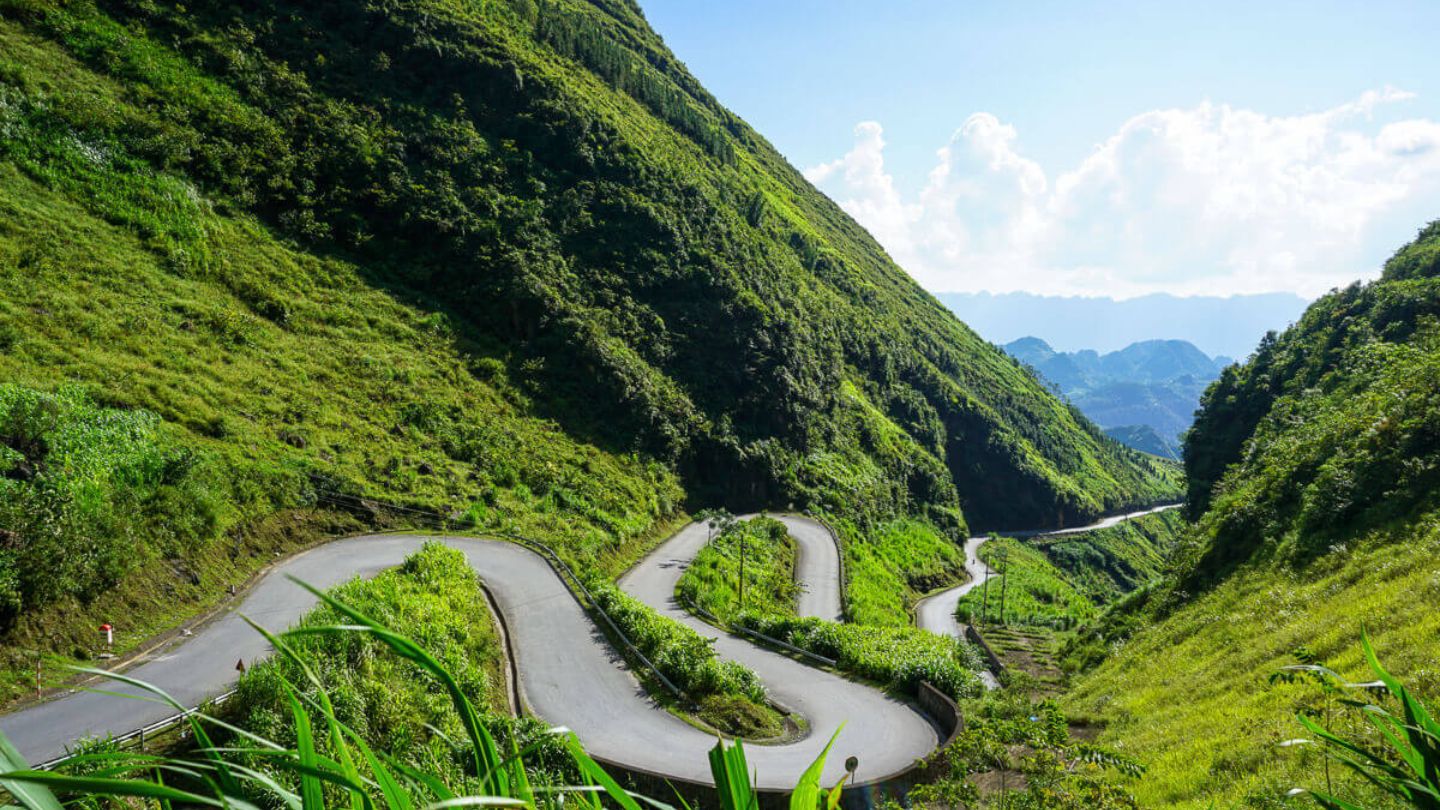
Unforgettable trekking routes in Ha Giang Loop
06 Sep, 2025
An Overview of Ha Giang Ha Giang, situated at the northernmost tip of Vietnam and sharing a border with China, is a province renowned for its breathtaking landscapes and cultural richness. Characterized by towering limestone mountains, winding passes, deep valleys, and terraced rice fields carved into the hillsides, the region offers an almost otherworldly beauty that captures the hearts of adventurous travelers. Unlike more commercialized destinations, Ha Giang retains its raw, untamed charm, making it a perfect setting for trekking and outdoor exploration. The province is home to more than 20 ethnic minority groups such as the H’Mong, Tay, Dao, and Lo Lo, whose traditional villages and vibrant markets bring unique cultural encounters to every journey. For trekkers, this means not only walking through dramatic mountain scenery but also immersing in authentic local life, where ancient customs and warm hospitality are still deeply preserved. Trekking in Ha Giang is both a physical and cultural adventure. Trails often wind through karst plateaus, remote valleys, and forested paths, rewarding hikers with panoramic views of iconic landscapes like the Ma Pi Leng Pass, Dong Van Karst Plateau, and rice terraces in Hoang Su Phi. Each route presents varying levels of challenge, from gentle walks through villages to strenuous climbs up rugged mountain ridges, making Ha Giang a destination suitable for both casual hikers and seasoned adventurers. With its combination of untouched natural beauty, rich ethnic traditions, and diverse trekking trails, Ha Giang is undoubtedly one of Vietnam’s most unforgettable destinations for those seeking both adventure and cultural discovery. Trekking Highlights in the Ha Giang Loop Dong Van Karst Plateau Geopark A UNESCO-recognized site, Dong Van Karst Plateau is a must for hikers who love dramatic scenery. The trekking trails here lead you across ancient limestone formations, steep valleys, and charming ethnic minority villages. The views are spectacular, especially at sunrise and sunset when the mountains glow with golden hues. Ma Pi Leng Pass Trekking Route Known as the "King of Passes" in Vietnam, Ma Pi Leng offers one of the most iconic trekking experiences in Ha Giang. Hiking along its rugged paths gives you a chance to admire panoramic views of the Nho Que River winding through deep canyons. It’s a challenging trek but worth every step for the jaw-dropping scenery. Lung Cu Flag Tower and Surroundings For those who enjoy combining trekking with cultural experiences, Lung Cu is the perfect choice. A moderate hike takes you up to the northernmost point of Vietnam, marked by the Lung Cu Flag Tower. The journey also passes through traditional Hmong villages, where you can learn about local customs and daily life. Hoang Su Phi Rice Terraces If you’re trekking between September and October, the rice terraces of Hoang Su Phi are at their most stunning. The trails here meander through golden fields, misty hillsides, and quiet farming hamlets. It’s an ideal route for travelers seeking peaceful scenery and authentic encounters with ethnic minority communities. Tips for Trekking in Ha Giang Best time to visit: March–May and September–October for the most pleasant weather and stunning landscapes. Guides: Consider hiring a local guide for safety and to learn more about the culture. Gear: Good hiking shoes, light layers, and rain protection are essential. Respect: Always be mindful when visiting villages—ask before taking photos and support local services when possible. Trekking in the Ha Giang Loop is an adventure filled with natural beauty, cultural immersion, and unforgettable moments. Whether you’re conquering the Ma Pi Leng Pass, wandering through the rice terraces of Hoang Su Phi, or standing proudly at Lung Cu, each route offers a unique perspective of this northern paradise. For travelers seeking more than just sightseeing, Ha Giang promises an experience that stays in the heart long after the journey ends.
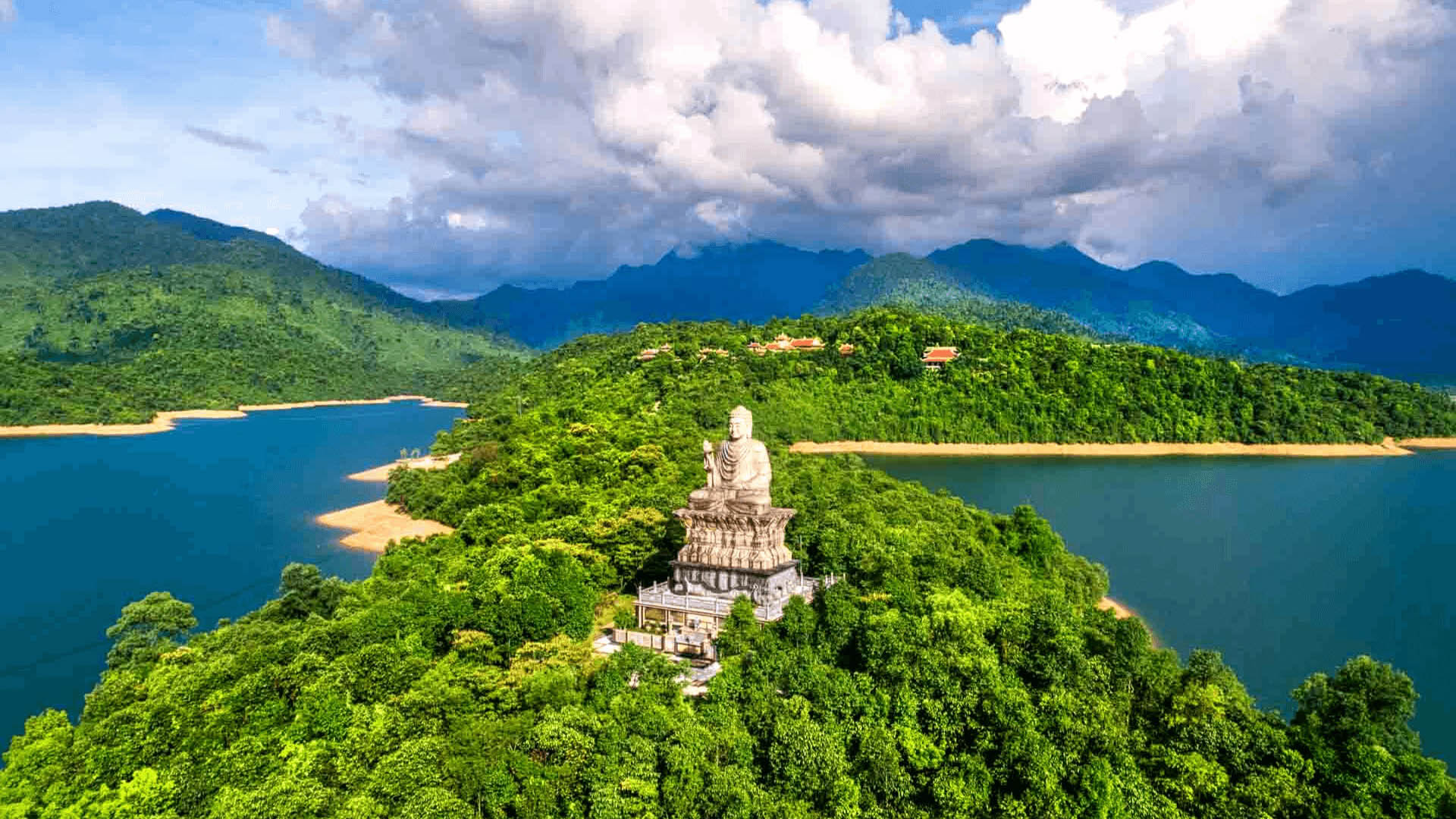
Exploring Bach Ma National Park – The hidden gem for hikers in Central Vietnam
06 Sep, 2025
General Information about Bach Ma National Park Bach Ma National Park was established in 1991 to protect the unique flora and fauna of the Annamite Mountains. Covering an area of over 37,000 hectares, the park stretches from the coast to the high mountains, creating diverse habitats that are home to more than 2,000 species of plants and 1,400 species of animals. The highest point in the park is Bach Ma Peak, which rises 1,450 meters above sea level. Thanks to its altitude, the climate here is refreshingly cool year-round, making it an ideal destination to escape Vietnam’s tropical heat. Located just 40 km from Hue city and 65 km from Da Nang, the park is easily accessible for day trips or longer nature explorations. Bach Ma is renowned for its natural beauty. As you venture deeper into the park, you’ll find yourself surrounded by dense evergreen forests, tranquil lakes, and vibrant orchid gardens. The park’s altitude variations allow visitors to experience a remarkable range of landscapes, from coastal plains to mist-covered peaks. The Five Lakes (Ngu Ho) area is a favorite among visitors, consisting of five crystal-clear lakes connected by small waterfalls. It’s a perfect spot to relax, swim, or enjoy a picnic in the middle of nature. Another highlight is Do Quyen Waterfall, a majestic cascade plunging 300 meters down the cliffs. In spring, rhododendron flowers bloom along its banks, adding even more beauty to the scene. For panoramic views, the summit of Bach Ma Peak offers breathtaking vistas of Lang Co Beach, Hai Van Pass, and the Cau Hai Lagoon below. On clear days, you can even see both the East Sea and the lush valleys that surround the region. Hiking Trails in Bach Ma National Park Bach Ma is a hiker’s paradise, with trails suited for all levels of fitness and adventure. From gentle walks through lush forests to challenging ascents leading to panoramic mountain views, the park offers something for everyone. Along the way, you’ll encounter cool streams, cascading waterfalls, and a rich diversity of wildlife. Whether you’re a casual nature lover or an experienced trekker, Bach Ma promises a rewarding journey into one of Central Vietnam’s most breathtaking natural landscapes. Bach Ma Summit Trail: A relatively easy trek leading to the park’s highest point at 1,450 meters. The trail winds through lush forests and rewards hikers with sweeping views at the summit. Five Lakes Trail: A moderate hike that takes you through the forest to the chain of five lakes. Along the way, you’ll encounter small waterfalls and natural swimming holes—perfect for cooling off on a hot day. Do Quyen Waterfall Trail: One of the most challenging treks in the park. The trail descends more than 600 steps to the base of the waterfall, offering incredible photo opportunities and an exhilarating sense of adventure. Pheasant and Orchid Trails: Shorter routes designed for wildlife and plant observation, ideal for those interested in birdwatching and exploring the park’s rich biodiversity. Each trail is well-marked, but it’s recommended to hire a local guide if you want to discover hidden spots and learn more about the park’s ecosystem. Activities and Experiences at Bach Ma National Park Beyond hiking, Bach Ma offers a wide range of activities for nature enthusiasts. Birdwatching is a highlight, as the park is home to rare species like the crested argus and Vietnamese pheasant. Photography enthusiasts will find endless inspiration, from misty forests and dramatic waterfalls to colorful butterflies and exotic flowers. Camping is another exciting option for those who want to immerse themselves in nature overnight. With the sound of rushing streams and the fresh mountain air, it’s an experience that leaves lasting memories. For history lovers, Bach Ma also has remnants of French colonial villas built in the early 20th century when the French developed the area as a hill station retreat. Exploring these ruins adds a cultural layer to your adventure in the park. Travel Tips for Visiting Bach Ma National Park Best time to visit: March to September is ideal, with dry weather and clear skies. Avoid the rainy season (October–December) when trails can be slippery. Entrance fee: Around 60,000 VND per person. What to bring: Comfortable hiking shoes, insect repellent, sunscreen, a hat, snacks, and plenty of water. How to get there: From Hue, it takes about 1.5 hours by car or motorbike. Guided tours are available from both Hue and Da Nang. Fitness level: Most trails are moderate, but some like the Do Quyen Waterfall require good stamina. Bach Ma National Park is more than just a hiking destination—it’s a place where travelers can reconnect with nature and discover the untouched beauty of Central Vietnam. From its sweeping mountain vistas and thundering waterfalls to its rich biodiversity and serene lakes, every corner of the park has something special to offer. For those seeking an escape from the city and an adventure into the wild, Bach Ma truly is a hidden gem waiting to be explored.
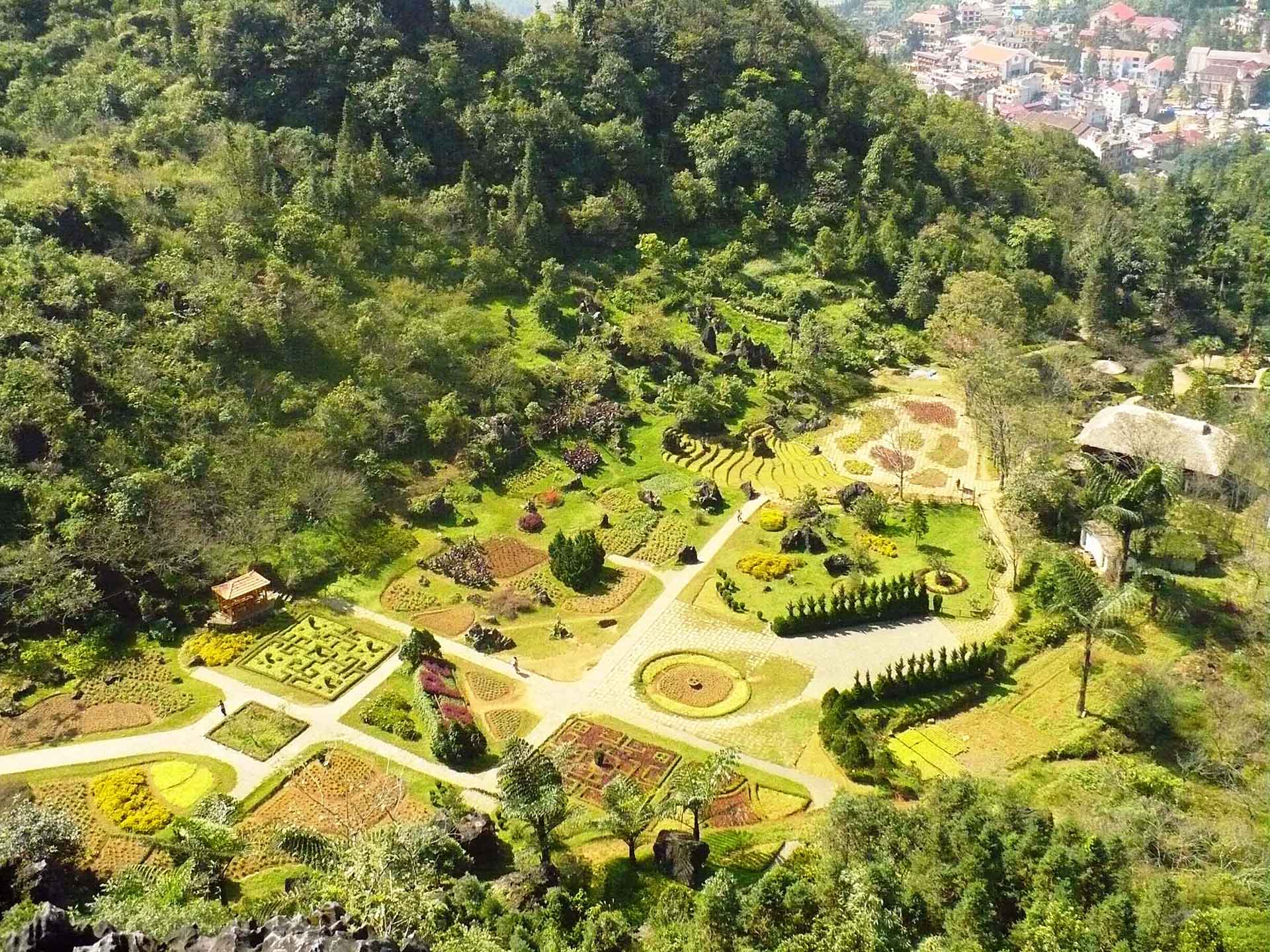
Discover the breathtaking beauty of Ham Rong Mountain
06 Sep, 2025
A Symbolic Peak of Sapa Nestled right in the heart of Sapa town, Ham Rong Mountain is one of the most iconic landmarks in Northern Vietnam. Rising 1,800 meters above sea level, this mountain is not just a natural attraction but also a cultural symbol, offering visitors a perfect blend of panoramic views, colorful gardens, and a touch of local legend. Its name, meaning “Dragon Jaw,” comes from the shape of its peak, resembling the head of a dragon gazing proudly at the sky. The climb to Ham Rong Mountain rewards travelers with spectacular vistas. From the viewing platforms, visitors can take in sweeping views of Sapa town, terraced rice fields, and majestic peaks like Fansipan, the “Roof of Indochina.” On clear days, the sight of clouds drifting across the valley creates a magical atmosphere that makes Ham Rong one of the best spots for photography in Sapa. A Garden of Flowers and Orchids One of the highlights of Ham Rong Mountain is its orchid garden, home to more than 200 species of orchids blooming in vibrant colors. Along the trails, you’ll also find themed gardens such as the European Garden, Cloud Garden, and peach blossom groves, which paint the mountain with a kaleidoscope of colors throughout the year. The floral displays make Ham Rong a must-visit for nature lovers and photography enthusiasts. Springtime brings a special charm to Ham Rong, when peach blossoms, plum blossoms, and orchids bloom in unison, turning the mountain into a floral wonderland. Meanwhile, autumn offers golden-hued landscapes and crystal-clear skies—perfect for trekking and sightseeing. As you wander through the mountain’s paths, you may also encounter performances of traditional dances and folk music by ethnic minority groups such as the H’Mong and Dao. These cultural activities add a deeper layer of meaning to your journey, offering insights into the heritage of the region. How to Visit Ham Rong Mountain Ham Rong Mountain is conveniently located just a few minutes’ walk from the center of Sapa town, making it easily accessible for all visitors. The entrance fee is around 70,000 VND for adults and 30,000 VND for children. The best time to visit is in spring, from February to April, when flowers are in full bloom and the weather is pleasant. Autumn, from September to November, is also ideal for enjoying clear skies and stunning views. With its harmonious combination of natural landscapes, vibrant gardens, and cultural charm, Ham Rong Mountain is a destination that truly captures the essence of Sapa. Whether you’re seeking breathtaking views, peaceful walks through flower gardens, or a glimpse into local traditions, a visit to Ham Rong will leave you with unforgettable memories of Northern Vietnam’s beauty. Top Things to Do in Ham Rong Mountain Climb to the Cloud Yard (Sân Mây) The Cloud Yard is one of the most popular viewpoints on Ham Rong Mountain. Standing here, you’ll feel like you are floating above the clouds while gazing at the breathtaking panorama of Sapa, Muong Hoa Valley, and Fansipan Mountain. Visit the Orchid Garden With over 200 species of orchids, this garden is a feast for the senses. Take your time to explore the vibrant flowers, capture stunning photos, and enjoy the fragrant air. Stroll through Themed Gardens Don’t miss the European Garden, Cloud Garden, and peach blossom groves. Each garden has a unique character and is designed to highlight both local and exotic plants, making your walk more enjoyable. Enjoy Ethnic Minority Performances Traditional dances and folk songs performed by the H’Mong, Dao, and Tay people are staged at various points along the trails. These performances showcase the unique traditions and vibrant culture of Sapa’s ethnic communities. Capture Stunning Photos Every corner of Ham Rong Mountain offers a new photo opportunity—whether it’s a sea of clouds, blossoming flowers, or traditional performances. It’s a dream location for photographers and Instagram lovers alike. Relax and Connect with Nature Ham Rong Mountain is also a place for peace and relaxation. Take a leisurely stroll, breathe in the fresh mountain air, and enjoy the sense of calmness away from the bustling town center. With its harmonious combination of natural landscapes, vibrant gardens, and cultural charm, Ham Rong Mountain is a destination that truly captures the essence of Sapa. Whether you’re seeking breathtaking views, peaceful walks through flower gardens, or a glimpse into local traditions, a visit to Ham Rong will leave you with unforgettable memories of Northern Vietnam’s beauty.
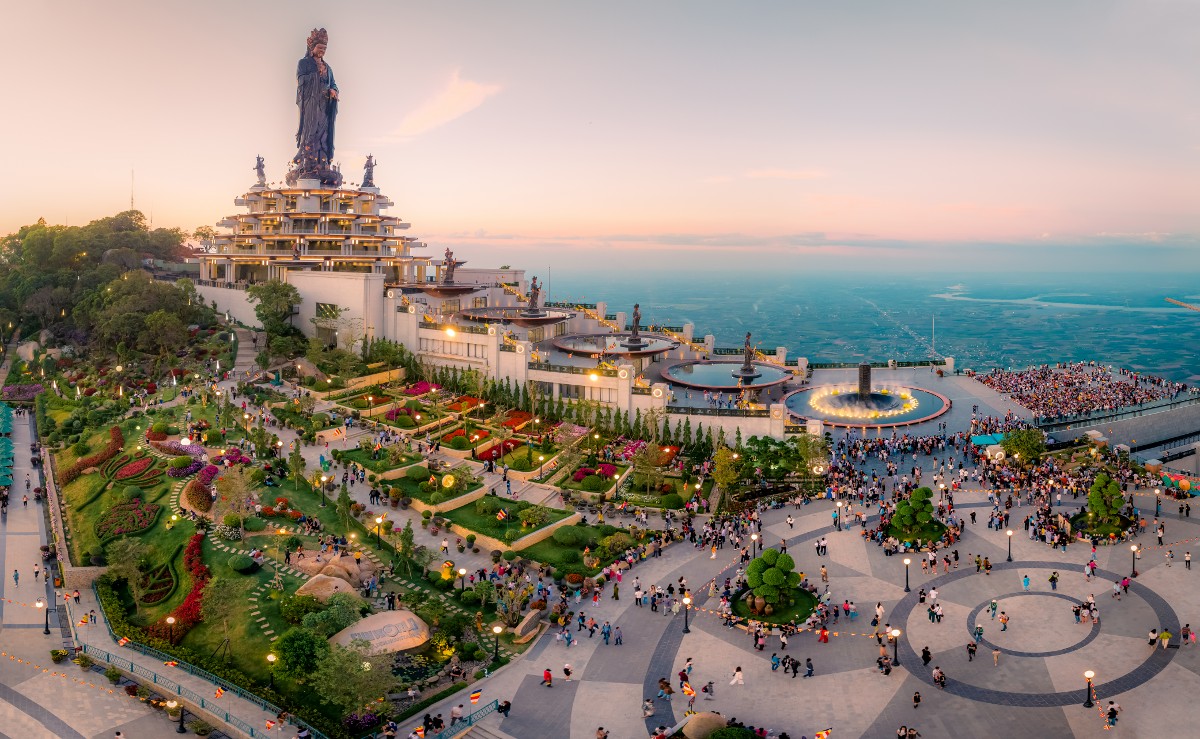
Exploring the spiritual and natural wonders of Ba Den Mountain
06 Sep, 2025
About Ba Den Mountain (Black Virgin Mountain) Ba Den (Black Lady) Mountain is an iconic tourist attraction in the southern province of Tay Ninh. The complex, which is also a famous spiritual site as it contains the Linh Son Tien Thach pagoda, attracts millions of visitors every year. This mountain boasts an impressive altitude of 986 meters, making it the tallest peak in the entire South of Vietnam. This soaring height contributes to the allure of the site, attracting visitors from far and wide. The natural scenery surrounding Ba Den Mountain is simply enchanting, with awe-inspiring landscapes that captivate the hearts of all who venture there. From the base to the top of the mountain, visitors can stop by temples, pagodas and towers, whose architecture is a blend of Buddhist and folklore culture. Top things to do on the trip to Ba Den Mountain Admire the scenery of Black Virgin Mountain on a cable car To facilitate access to Ba Den Mountain and enhance the overall experience for visitors, a cable car route has been established. The Ba Den cable car allows travelers to effortlessly ascend to the mountain's peak, providing you with breathtaking panoramic views of the surrounding landscapes and an opportunity to appreciate the historical and tourist attractions from above. The prices of cable car tickets to Ba Den Peak range from 150,000 to 250,000 VND per person. Take a Black Virgin Mountain hike Despite the convenience of the Black Virgin Mountain cable car, many adventurous young people still prefer to embark on a more traditional and challenging journey, which is conquering the roof of the South by road. The exhilarating experience of trekking and climbing the slopes of Ba Den Mountain offers a sense of achievement and closeness to nature that cannot be replicated with a cable car ride. Along the road, you can encounter the local wildlife and relish in the sense of triumph upon reaching the summit. Visit sacred pagodas on Black Virgin Mountain During a Ba Den Mountain tour, tourists will have an opportunity to explore numerous famous pagodas, each holding its own significance and allure. Some prominent pagodas that grace the mountain's base include Ba Tay Ninh Pagoda, Hang Pagoda, Linh Son Hoa Dong Pagoda, Linh Son Phuoc Trung Pagoda, and Quan Am Pagoda. Among them, Ba Den Pagoda stands out with its profound history of over 300 years, serving as a sacred destination that attracts countless pilgrims. Capture the memories at stunning viewpoints Visiting Ba Den Mountain in Tay Ninh, a must-do activity for tourists is capturing picturesque moments at some of the famous places that offer stunning views. The cliff on the summit of Ba Den Mountain is a prime spot for capturing breathtaking photos. From this vantage point, visitors are treated to an expansive view of the mesmerizing natural scenery that surrounds the mountain. As travelers journey through Ba Den Mountain, they will come across the "balcony" area, enveloped by swirling clouds. This spot provides an otherworldly backdrop for photos, with the misty veil adding an element of mystery and enchantment to the pictures. Extra tips for the best experiences at Ba Den Mountain Consider the time to visit, preferably when there is sunny weather and no storms. If you prefer climbing, choose the route that suits your fitness level and preferences. Prepare comfortable clothes and sports shoes for ease of movement. Pack essential items such as insect repellent, lighter, raincoat, and sunscreen. Stay hydrated and take regular breaks during the climb to rest and re-energize. Consider traveling in a group, or inform someone you trust about your plan if going solo. Ba Den Mountain is more than just the highest peak of Southern Vietnam – it is a harmonious blend of natural beauty, cultural heritage, and spiritual significance. Whether you choose to glide to the top by cable car, challenge yourself with a hike, or immerse in the sacred atmosphere of its ancient pagodas, every moment here promises a unique and memorable experience. With breathtaking landscapes, rich legends, and serene spiritual sites, Ba Den Mountain continues to stand as a must-visit destination for travelers seeking both adventure and tranquility.
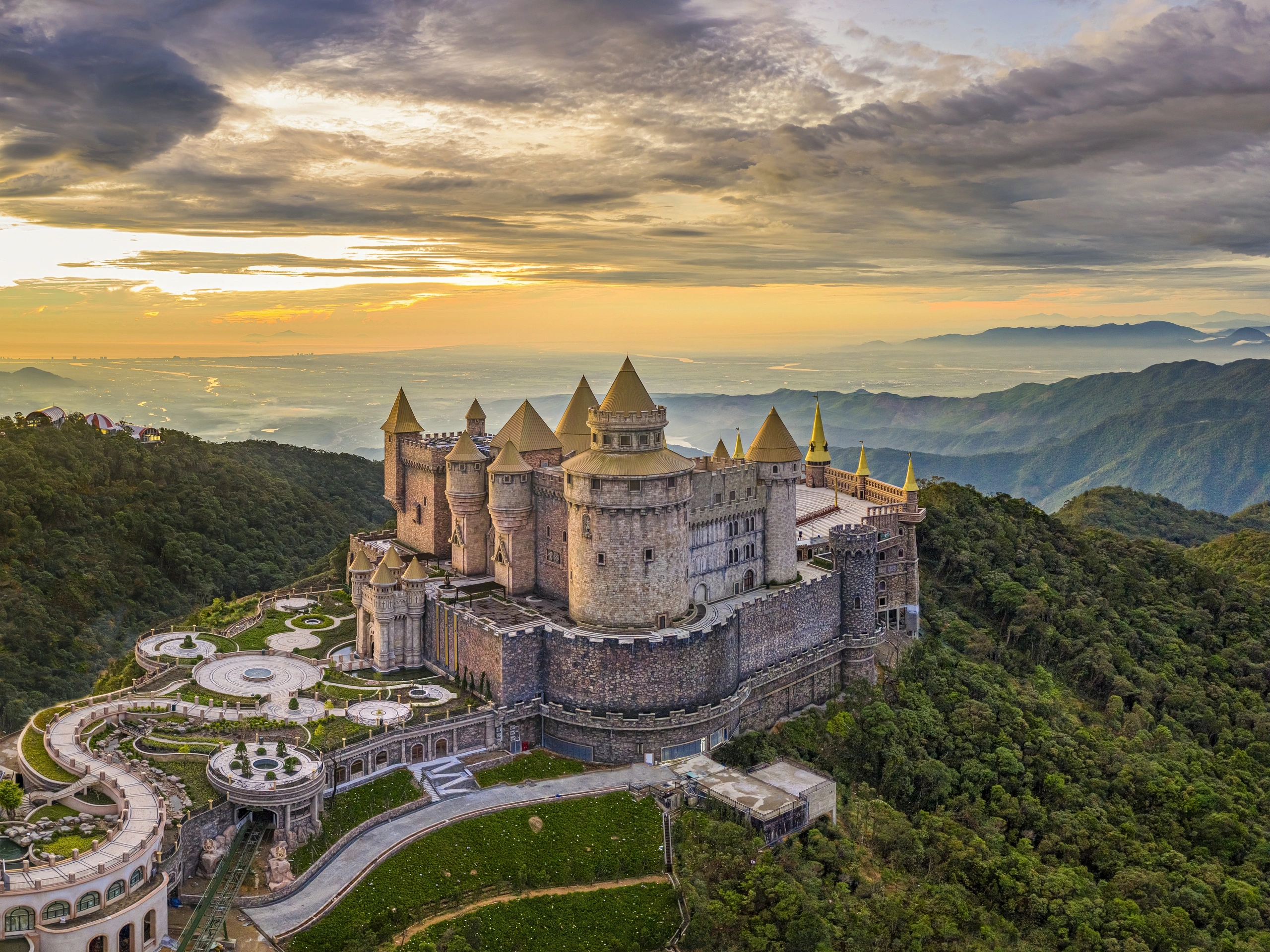
Ba Na Hills: A mountain retreat above the clouds
06 Sep, 2025
Located just 69.5 kilometres from Ba Na Hills, Angsana Lăng Cô highlights this recreational complex in the Truong Son Mountains as a must-visit for families travelling with kids. Wander down cobblestone paths, enjoy thrilling entertainment and create unforgettable memories with your loved ones at Ba Na Hills. The World’s Most Famous Cable Car Ride Getting to Ba Na Hills is an adventure in itself. The only way up is to take the Ba Na Hills cable car system, the longest non-stop single-track cable car system in the world. Opened in 2013, it stretches 5,801 metres through the clouds. The ride to the top takes around 25 to 30 minutes and offers breathtaking, 360-degree views throughout the ascent. As you glide above dense jungle, tumbling waterfalls and winding forest trails, be sure to have your camera ready. On sunny days, you can see as far as Da Nang and the shimmering coastline. Within the complex: Suoi Mo – Ba Na, Debay – Morin, Toc Tien – L’Indochine, Hoi An – Marseille, and Bordeaux – Louvre. Whichever route you take, you’ll be rewarded with unforgettable views. To make the most of the journey, go early on a sunny day. Fog and mist can roll in quickly and hide the views, and this is one ride you’ll want clear skies for from start to finish. Step into the heart of Ba Na Hills in Vietnam and find yourself transported to 19th-century France. Modelled after a classical and romantic French village, this mountaintop town was built to evoke the charm and elegance of old Europe. Originally conceived during the French colonial era as a hill station retreat, it was later reimagined as a whimsical theme park for modern travellers.The village’s architecture is decidedly European. Stone facades, steeply pitched roofs and timber-framed windows line cobblestone paths that wind through quiet alleyways. At the centre stands the Saint Denis Church, an imposing Gothic-style cathedral inspired by the original in Paris. Surrounded by buildings seemingly plucked from fairytales, you’ll feel as though you’ve wandered into a storybook. Seasonal events bring extra magic, from Halloween festivities to vibrant flower and winter festivals.Before heading up, check the monitors at the base of the park. The cable car station shows live footage from the top, as sunny skies below can quickly give way to mist and rain above. Top Things to Do in Ba Na Hills Take the cable car and admire the panoramic view The Ba Na Hills cable car has set several world records for its length and height. Sitting inside the cabin feels like flying through the clouds, offering breathtaking views of pristine forests, cascading waterfalls, and majestic mountains. This is the perfect way to begin your journey. Visit the legendary Golden Bridge The Golden Bridge has become a global tourism icon with its unique design – giant hands appearing to lift the bridge high above the ground. From here, visitors can marvel at the stunning mountain scenery, sea of clouds, and fresh, cool air. Don’t miss the chance to capture unforgettable photos as you stroll across this masterpiece. Explore the French Village Step into the charm of 19th-century Europe at the French Village, with its churches, castles, squares, and cobblestone streets. Walking through feels like being transported to an ancient European town, where every corner makes a perfect photo backdrop. Wander through Le Jardin D’Amour Flower Gardens Le Jardin D’Amour is a complex of nine gardens, each with its own unique design, from romantic French styles to vibrant Mediterranean themes. Surrounded by countless blooming flowers all year round, it’s the perfect place for a leisurely stroll, relaxation, and stunning photos. Visit Debay Wine Cellar Built by the French in 1923, Debay Wine Cellar lies deep inside the mountain, maintaining a cool temperature all year. Visitors can learn about wine storage, explore its historic architecture, and even sample some fine wines while feeling transported to a European-style cellar in the middle of Vietnam’s mountains. Have fun at Fantasy Park Known as the “indoor entertainment paradise,” Fantasy Park features more than 100 games ranging from thrilling rides such as free-fall towers and alpine coasters to kid-friendly activities. You’ll also find 4D cinemas and interactive games that make it fun for the whole family. Stroll and enjoy the refreshing atmosphere Nicknamed “heaven on earth,” Ba Na Hills is blessed with a cool climate all year round. Walking along its winding paths, visitors can admire rolling mountains, breathe in fresh mountain air, and enjoy a rare sense of peace and relaxation. Savor diverse cuisine Ba Na Hills offers a wide range of dining options, from buffet restaurants to à la carte meals, blending Vietnamese specialties with Asian and European flavors. Dining here is not only about food but also about enjoying the unique atmosphere in beautiful European-style settings. Discover Linh Ung Pagoda and the giant Buddha statue The 27-meter-high Buddha statue sits solemnly on the mountaintop, surrounded by clouds and forests, creating a serene and spiritual space. It’s an ideal spot for visitors to seek peace and tranquility while admiring the sacred beauty of the mountains. Join colorful festivals all year round Ba Na Hills is always lively with events such as the vibrant Carnival Festival, the blooming Flower Festival, and the exciting Wine Festival. No matter what season you visit, you’ll always find something festive and memorable to enjoy. Ba Na Hills is more than just a tourist attraction – it is a unique blend of natural beauty, cultural charm, and world-class entertainment that makes every visit unforgettable. From soaring cable cars and the iconic Golden Bridge to the fairy-tale French Village and colorful festivals, this mountaintop destination has something for everyone. Whether you’re seeking adventure, relaxation, or family fun, Ba Na Hills promises memories that will last a lifetime.
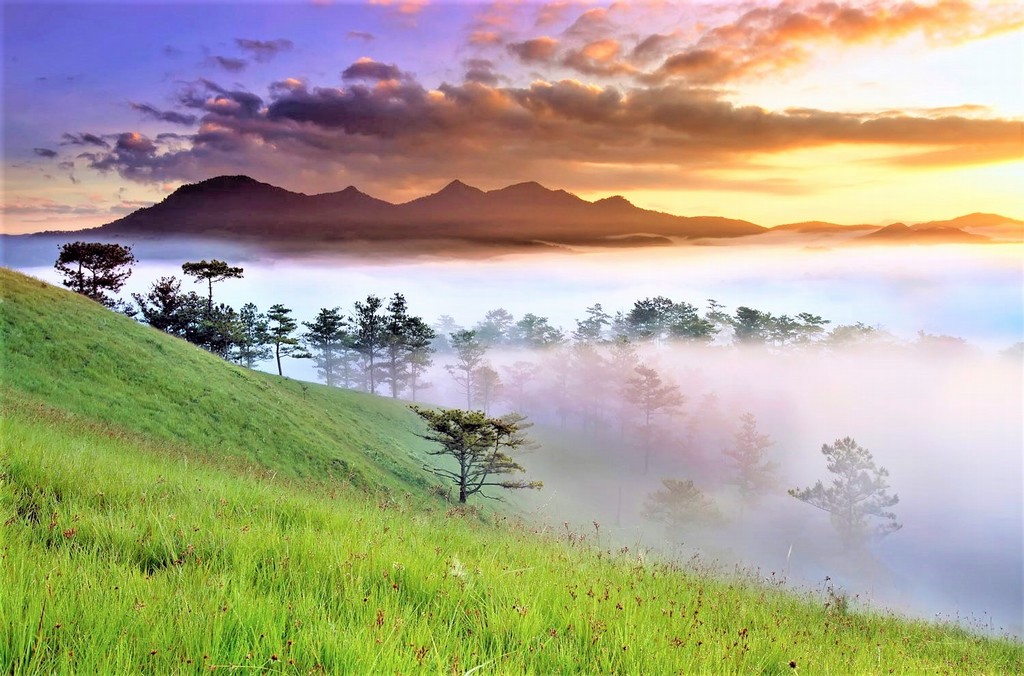
The Timeless Charm of Lang Biang in Vietnam’s Central Highlands
06 Sep, 2025
The Legend of Langbiang Mountain Langbiang Mountain is located in Lac Duong district which is 12 km from Dalat in the North. With its height of 2,169m above the sea level, Langbiang Mountain has not only been an attractive tourist site but also kept a legend about a passionate love. According to the old people, there was a love story of K'Lang (a boy of Lach minority people) and Ho-biang (a girl of Chil minority people). Their families both lived at the foot of the mountain. They met each other by chance and then they were beloved. However, they were at different tribes, so Ho-biang couldn't get married to K'Lang. Finally, they decided to overcome their strict customs and got married. Then they left their hometown and came to live in a place in the top of the mountain. One day, Ho-biang was ill, K'Lang managed to cure his wife but she couldn't get over her illness. K'Lang decided to go back Ho- biang village to inform people about her illness. However, because Chil people hated him, they prepared a bow and a poisoned arrow to kill him. Suddenly, Ho-biang went to stand before K'Lang to prevent her husband from the arrow. The arrow shot her and she died. K'Lang cried a lot and he also died. His tear turned into a scream that we call DanKia now. After the death of K'Lang and Ho-biang, the father of Bian realized what he did before was wrong, so he united all the hill tribes of Lach, Chil, Sre, etc and they all became one hill tribe, K'ho. Since then, the boys and girls of the hill tribes can get married with each other. The tombs of Lang and Biang turned into two mountains standing with each other, so the local people gave the name Langbiang for the mountains. Nowadays, Langbiang tourist site has been known by a lot of local and foreign tourists with its multiform biology of plants, animals and its attractive amusements such as climbing mountain, camping, taking eco-tours and researching native culture. Essential information for tourists visiting Lang Biang Mountain Opening hours: 7 am - 5 pm Ticket price: 50,000 VND/adult and 25,000 VND/child Motorbike parking ticket: 5,000 VND/vehicle Jeep rental price: 720,000 VND/vehicle (each Jeep can carry up to 6 people) Must-try activities on your excursion to Lang Biang Mountain Whether it is hiking Lang Biang Mountain, immersing in the local culture, or simply reveling in the tranquility of nature, this place captures the hearts and minds of all who venture to its slopes. At the foot of the mountain Beyond its scenic beauty, Lang Biang Mountain Da Lat offers a glimpse into the rich cultural heritage of the region. Here, visitors can engage with local communities, learn about their customs, and savor traditional dishes, creating an immersive and enriching cultural experience. Explore Tram Nam Valley Tram Nam Valley, nestled within the enchanting Lang Biang Mountain, is a hidden gem of natural beauty. With its rolling hills, vibrant flower fields, and picturesque landscapes, the valley offers a serene and captivating escape. Visitors can immerse themselves in the tranquility of nature, take leisurely walks, and capture stunning photographs in this idyllic setting. Enjoy dishes of the Central Highlands Lang Biang Mountain offers a delectable array of dishes that showcase the region's unique culinary heritage. Indulge in the flavors of Central Highland cuisine, which includes mouth-watering dishes like banh can (rice cake with quail eggs), goi la (Vietnamese salad), and com lam (rice in bamboo tubes) with grilled chicken. Visit the coffee farms of the K'Ho people At the foot of Lang Biang Mountain, visitors can delve into the rich coffee culture of the K'ho people. The K'ho coffee farms offer a unique opportunity to witness the traditional cultivation and processing methods of coffee beans. Immerse yourself in the aroma, taste freshly brewed coffee, and learn about the deep connection between the K'ho community and their cherished coffee heritage. On the top of the mountain Adventurous souls can embark on a trek up Lang Biang Mountain, navigating through lush forests, and ascending its slopes to be rewarded with the panoramic views of Da Lat. Go to the top of the mountain by Jeep A Jeep ride to the top of Lang Biang Mountain offers an exhilarating adventure and an alternative way to experience its breathtaking heights. Navigating the winding roads, visitors can enjoy the scenic journey while soaking in the panoramic vistas. Try paragliding Paragliding enthusiasts can partake in this exhilarating activity at the top of the mountain. With its elevated vantage point and favorable wind conditions, the mountain offers a thrilling opportunity to soar through the skies and witness breathtaking views of the surrounding landscapes. Join hiking tours Taking a Lang Biang Mountain hike is a popular activity for nature enthusiasts seeking an immersive experience amidst the breathtaking landscapes here. Guided hiking tours offer tourists a chance to conquer the mountain’s heights, explore pristine trails, and soak in the awe-inspiring scenery of Da Lat. Camp overnight Camping overnight at the top of the mountain offers a unique opportunity to immerse oneself in the untamed beauty of nature. Set up your tent amidst the serene surroundings, breathe in the crisp mountain air, and marvel at the star-filled sky above. Lang Biang Mountain is more than just a natural wonder of Da Lat – it is a place where breathtaking scenery, rich cultural heritage, and timeless legends come together. Whether you are drawn by the story of K’Lang and Ho-Biang, eager to hike its trails, or simply wish to enjoy the tranquil highland atmosphere, Lang Biang offers an unforgettable experience for every traveler. A visit here is not only about conquering a peak but also about connecting with the soul of Vietnam’s Central Highlands. Lang Biang Mountain is more than just a natural wonder of Da Lat – it is a place where breathtaking scenery, rich cultural heritage, and timeless legends come together. Whether you are drawn by the story of K’Lang and Ho-Biang, eager to hike its trails, or simply wish to enjoy the tranquil highland atmosphere, Lang Biang offers an unforgettable experience for every traveler. A visit here is not only about conquering a peak but also about connecting with the soul of Vietnam’s Central Highlands.
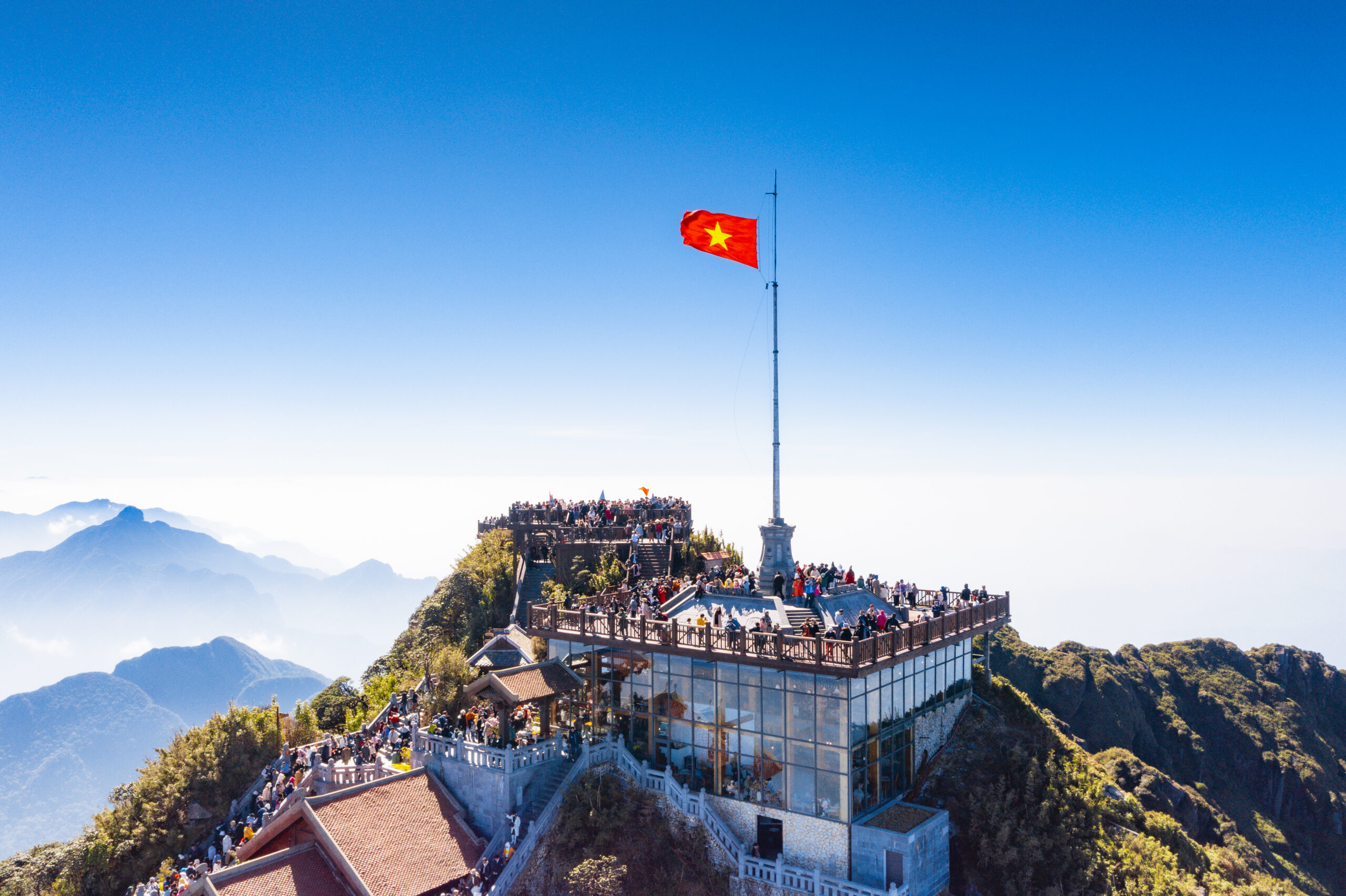
Journey to Fansipan Mountain- the iconic Peak of Indochina
06 Sep, 2025
Fansipan Mountain, the highest mountain in Vietnam and all of Indochina, stands tall at 3,147 meters. Known as the “Roof of Indochina,” it’s a must-see for nature lovers and thrill-seekers. Whether you're tackling the summit by hiking or soaring up with the famous cable car, this adventure offers breathtaking views and unforgettable experiences. In this guide, you'll find everything you need to know - from practical tips and hiking routes to must-see highlights. 7 Facts About Fansipan Mountain, Sapa Fansipan is the highest mountain in Vietnam and Indochina, standing at 3,147 meters. It is located in the Hoang Lien Son mountain range, within Hoang Lien National Park, a UNESCO-recognized area. Fansipan is famously known as "The Roof of Indochina," attracting nature lovers and adventure seekers. Situated 9 km southwest of Sapa, it forms part of the eastern extension of the Himalayas. Once a "holy grail" for climbers, Fansipan has become more accessible with the development of a cable car system. The mountain experiences extreme weather conditions, including fog, mist, and occasional snow in winter. Fansipan holds cultural and spiritual importance for the local ethnic groups, such as the H'mong and Tay people, who consider it sacred. Why Fansipan Mountain Should Be on Your Travel List Breathtaking views from the summit Fansipan mountain offers some of the most stunning views in Vietnam. From the summit, you can admire the panoramic beauty of Muong Hoa Valley and its lush terraced rice fields - an iconic sight of Sapa. On misty days, you might even witness the mesmerizing "sea of clouds", where fluffy clouds roll over the peaks, creating an otherworldly landscape. It’s nature at its most dramatic and serene. Thrilling hike for the adventurous For those who love a challenge, the hike to the Fansipan peak is a must. The hike usually takes 2-3 days, depending on your fitness level, and offers an authentic, raw experience of Vietnam’s northern mountains. You’ll pass through dense forests, cross streams, and navigate steep inclines. Along the way, you'll meet local H’mong and Tay ethnic minorities, who will share their stories and traditions. Fansipan cable car: a unique experience If hiking isn’t your thing, no worries! The Fansipan cable car offers a quick, exhilarating way to reach the summit. The ride is a journey in itself - spanning 6,000 meters and taking you over breathtaking landscapes at an altitude of over 3,000 meters. You'll feel the wind in your face and get a bird’s-eye view of the beautiful terraced rice fields and valleys below. It’s perfect for families or anyone looking to experience the beauty of Fansipan without breaking a sweat. Cultural insights at the summit At the summit, you'll find a large bronze statue of the Bodhisattva Avalokitesvara, which represents peace and serenity. This spiritual site adds a cultural dimension to your experience, and many visitors take time to reflect and enjoy the peaceful atmosphere. It's a unique combination of nature and culture that makes Fansipan mountain even more special. Best time to visit Fansipan The best time to visit Fansipan is from late September to April, with each season offering something unique. Spring (March–May) is especially magical, with cherry and plum blossoms painting the slopes in vibrant colors. By late April, azaleas bloom, creating a stunning red landscape that’s perfect for photos. Summer (June–August) brings cool weather to Fansipan, making it ideal for climbing. However, it's also the rainy season, so keep an eye on the forecast before heading out. You'll find flowers like roses, sunflowers, and hydrangeas competing with the mist for attention. Autumn (September–November) is considered the most beautiful time. The rainy season has ended, and the weather is cool and pleasant. It’s harvest season, so the terraced rice fields glow golden against the backdrop of the mountains, offering a breathtaking view. Winter (December–February) brings snow, which is rare in Vietnam but a special experience in Sapa. Many travelers come to see the snow-covered peaks and enjoy the crisp, chilly air, perfect for those seeking a winter adventure. No matter when you visit, Fansipan’s beauty will always leave you in awe. How to Reach Fansipan Mountain in Sapa, Vietnam There are 2 ways to get to Fansipan mountain: Fansipan Cable Car If you’re heading to Sapa, a visit to Fansipan is likely on your list, and there's now an easy way to conquer the "Roof of Indochina" without the steep hike: the Fansipan cable car. Opened in 2016, this world-record-holding cable car system is the longest three-rope cable car in the world, stretching an impressive 6,292 meters. With a journey time of just 15 minutes, it offers jaw-dropping aerial views of lush valleys and towering peaks along the way. The best part? You'll gain an elevation of 1,410 meters during that short ride, making you feel like you've scaled the entire mountain in no time. However, keep in mind that the summit can get crowded, especially with tourists eager to take in the views. For those seeking a quieter, more intimate sunrise experience, the hike might be the better option. Hiking to Fansipan When you decide to conquer Fansipan mountain, you'll have several routes to choose from, each with its own set of challenges and rewards. From relatively easy hikes to challenging climbs, every path offers a unique experience of Vietnam’s northern landscape. Here's a breakdown of the most popular ones: Tram Ton Pass: A scenic journey for all fitness levels The Tram Ton Pass route is one of the most popular for good reason. Starting at an altitude of 1,900 meters at the Tram Ton Pass, this trail offers a more moderate climb. It's perfect for those with an average level of fitness who want to experience the thrill of reaching the summit without pushing themselves to the extreme. The first section of this hike takes you through the forest, where you'll gradually climb to 2,200 meters. After around 6 hours of hiking, you'll reach a rest point at 2,800 meters, where you can catch your breath and marvel at the beauty surrounding you. From there, it’s another push to the summit. For most hikers, this route can be completed in 2 days and 1 night, but if you're experienced and fit, you can make it a one-day challenge. Either way, the natural beauty of the landscape will make the effort worth it. Imagine hiking through dense forests, across rocky terrain, and along scenic ridges - this is the route where you get to connect with nature truly. Insider tip: If you’re looking for a more budget-friendly option, you can hike with a local guide, but if you’re feeling adventurous, this route can be tackled independently. Sin Chai Village: A tough challenge for experienced climbers For those with more experience, the Sin Chai Village route offers a significantly more challenging hike. Starting at 2,200 meters, this path takes you higher and higher, pushing you to new altitudes and offering stunning mountain views along the way. As you hike towards the Fansipan mountain, the trail ascends to 2,800 meters and beyond, where the summit awaits. This route is definitely not for the faint of heart. With rugged terrain and an elevation gain that’ll make your legs burn, Sin Chai is ideal for seasoned climbers. Most hikers will need over two days and one night to reach the top, as the pace can be slow, especially when you're navigating through the steep, rocky sections of the climb. Cat Cat Village: The ultimate adventure for passionate climbers Are you a passionate mountaineer looking for the ultimate test of endurance? Then the Cat Cat Village route is for you. This is by far the hardest trail and should only be attempted by seasoned climbers. You’ll start from the beautiful Cat Cat Valley, situated just a short distance from the town of Sapa, and ascend through picturesque villages before continuing up toward Tram Ton or Sin Chai. This trail usually takes at least 3 days and 2 nights to complete, as the elevation and terrain require serious stamina and mental toughness. The journey is steep, the air thinner, and the views more expansive with every step you take. Expect to be completely immersed in nature, passing through remote villages and dense forests. What makes this route to Fansipan Mountain particularly unique is the chance to experience local cultures up close. The villages you pass through are home to indigenous tribes. Along the way, you can meet ethnic minorities who still live in these remote regions, offering a glimpse into their traditional lifestyles. Tips for Hiking Fansipan: Your ultimate guide to conquering Vietnam's highest peak Hiking to the Fansipan peak is one of the most exhilarating and rewarding experiences in Vietnam. Whether you're a seasoned mountaineer or a beginner looking for a challenge, tackling this 3,143-meter giant in Sapa is not something to be taken lightly. But don't worry, we are here to walk you through everything you need to know for an unforgettable hike. Get fit before you go First things first, let’s talk about fitness. Fansipan isn’t a walk in the park—it's a tough, steep climb, and only those in good physical condition should attempt it. Ideally, you want to start preparing 1-2 weeks before your hike. Take an hour each day to climb stairs and do some light running. This will help build your endurance and strength. If you have chronic health issues, it's best to consult a doctor before hitting the trail. This hike is only for the spirited and adventurous—so make sure you're physically ready! Dress smart (And layer up!) Sapa’s weather is unpredictable. It can be sunny at the bottom and foggy or rainy at the top, so layers are essential. Here's your packing checklist: Waterproof jacket (rain is common) Sweat-absorbent clothes (you’ll sweat, especially on the uphill) Good hiking boots (with strong grip—think cleats!) Long knee socks (protect your legs from insects and rocks) Hat & sunglasses (don’t underestimate the sun) A lightweight backpack (waterproof cover is a bonus) Essential items: Water, snacks (chocolate & dried fruits), first-aid kit, sunscreen, and insect repellent Hire a guide and porter You could tackle Fansipan Mountain independently, but having a guide and porter can make the experience smoother, safer, and way more enjoyable. Local porters are not just there to carry your bags—they know the mountain like the back of their hand and can share insights into the terrain, wildlife, and culture. Most porters are from the local ethnic communities, and they’re known for their festive spirits and rugged stamina. Many also double as guides, so you get both assistance and knowledge on the trail. If you go with a tour group, your guide will typically arrange all the logistics, including your official permit for hiking in Hoang Lien National Park. Don't skip this! You can get your permit from the Hoang Lien Center of Eco-tourism (near Cat Cat Village) before starting your hike. Safety first: Navigational tools & emergency prep Safety is a priority, especially in the remote highlands. It’s easy to get lost in the thick mist or dense jungle, so consider carrying a GPS tool to track your steps. Some hikers also use a two-way radio, as phone signals can be patchy in the mountains. Pack a headlamp, especially if you’re going for a multi-day hike to Fansipan Mount. You never know when you'll be caught in low visibility, and it’s better to be prepared than to fumble in the dark! Plan for the altitude Altitude sickness is a real concern, especially when you start climbing higher. As you ascend, the air gets thinner, which can cause dizziness or headaches. If you feel off, don’t hesitate to stop and rest. It’s always better to descend a bit if you feel unwell rather than push through the discomfort. A daypack with water and snacks will help you manage your energy. Keep refueling as you go to prevent fatigue and stay energized. Fansipan Mountain is not only the highest peak of Indochina but also a symbol of Vietnam’s majestic natural beauty. Whether you conquer it by trekking or take the cable car, the mountain rewards you with breathtaking views and unforgettable experiences. A journey to Fansipan is a chance to embrace adventure, discovery, and the true spirit of the Northwest.
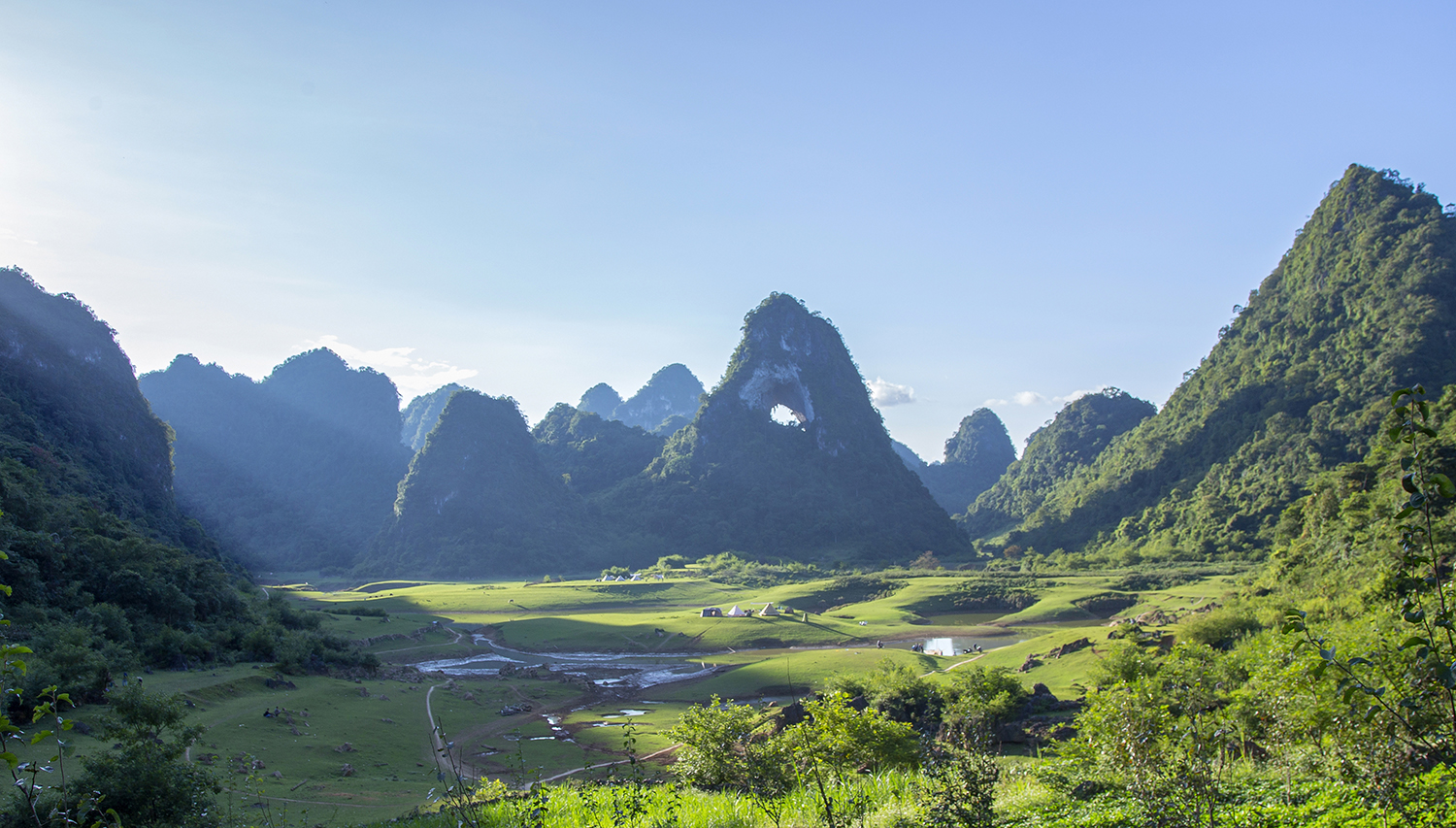
Admire the natural sculptures at Nui Thung Mountain
06 Sep, 2025
Nui Thung Mountain is a remarkable destination nestled within the Thang Hen Lake tourism complex, part of the Cao Bang Geopark in Northern Vietnam. This natural wonder enchants visitors with a breathtaking landscape of lush meadows, emerald lakes, and the sparkling Thang Hen Lake stretching across the horizon. For those planning a trip to Vietnam, Nui Thung offers both adventure and serenity in equal measure. Nui Thung Mountain is located in Danh village, Quoc Toan commune, Tra Linh district, Cao Bang province, Northern Vietnam. Locally known as “Angel Eye Mountain,” its name comes from a giant circular hole measuring approximately 50 meters in diameter that passes through the center of the mountain. This natural formation resembles a colossal eye gazing across the valley, giving the mountain its unique identity and making it a must-visit for photography enthusiasts and nature lovers alike. Things to do on your trip to Nui Thung Mountain Enjoy a picnic and admire the natural beauty Nui Thung Mountain is particularly popular among young travelers and adventure seekers. The mountain sits amid expansive plains dotted with 36 emerald lakes, creating a serene and photogenic environment. At the base of the mountain, visitors can set up a picnic, pitch tents on open meadows, or relax beside the tranquil lakes. Walking around the area allows travelers to fully immerse themselves in the charm of the verdant landscapes, snap memorable photos, and simply breathe in the freshness of the highland air. Explore other stunning destinations nearby Your visit to Nui Thung Mountain can be combined with several nearby natural wonders, each offering unique experiences: Ma Phuc Pass To reach Nui Thung Mountain from Cao Bang City, travelers often take the winding 3.5-kilometer Ma Phuc Pass, which rises approximately 700 meters above sea level. The pass is best explored by motorbike, allowing travelers to stop along the way and admire the breathtaking vistas. Recognized by UNESCO as a distinctive geological heritage site within Cao Bang Global Geopark, Ma Phuc Pass offers a journey as scenic as the destination itself. Thang Hen Lake Only a 10-minute drive from Nui Thung Mountain, Thang Hen Lake is the largest among a network of 36 lakes in the valley. Surrounded by mountains and dense jungle, it retains its striking blue color year-round, fed by pure water emerging from an underground cave. Visitors can stroll along its banks, take boat trips, or simply relax while enjoying the calm and peaceful atmosphere of this natural gem. How to get to Nui Thung Mountain Nui Thung Mountain is approximately 30 kilometers from Cao Bang City, accessible by both car and motorbike. For those renting a motorbike in Cao Bang, the route is straightforward: head north along QL3, ascend Ma Phuc Pass, and then turn left toward the valley rather than continuing straight to Ban Gioc Waterfall. After about 10 kilometers, a small sign will guide you into the valley where directional signs lead to the mountain and Thang Hen Lake. The drive itself offers spectacular views, making the journey as memorable as the destination. When is the best time to visit Nui Thung Mountain? Although Nui Thung Mountain can be visited year-round, the most picturesque period is during the harvest season from September to early October. During this time, golden rice fields decorate the valley below the mountain, contrasting beautifully with the deep green of surrounding forests and the clear blue waters of the lakes. The weather in Cao Bang is generally mild and comfortable, providing excellent conditions for trekking, photography, and outdoor activities. While in Cao Bang, travelers should consider visiting other well-known mountains and natural attractions such as Fansipan Mountain, Marble Mountains in Da Nang, Lang Biang Mountain in Da Lat, and Ta Cu Mountain in Binh Thuan. Beyond Cao Bang, Vietnam is filled with scenic destinations like Phu Quoc, Nha Trang, Hoi An, Da Nang, and Ha Long Bay, each offering unique experiences ranging from beaches and islands to cultural heritage and historical sites. Nui Thung Mountain is more than just a striking natural formation; it is an invitation to explore the raw beauty of Northern Vietnam. From the awe-inspiring “Angel Eye” to the serene lakes and vast meadows, it provides a peaceful retreat and countless photo opportunities. Combined with nearby attractions like Ma Phuc Pass and Thang Hen Lake, Nui Thung Mountain promises travelers an unforgettable journey through one of Vietnam’s most enchanting landscapes. Proper planning, including accommodation and transportation, ensures that every visitor can fully appreciate the magic and tranquility of this hidden
Experiences & Activities

Nha Trang Half-Day Snorkeling Adventure with BBQ Onboard
1 day
Relax at Vung Tau Beach Visit Christ the King Statue Explore Whale Temple (Den Ca Ong) Discover the historic White Palace (Bach Dinh) Admire the panoramic sea view at Nghinh Phong Cape

A romantic & adventurous Vietnam journey in 10 days 9 nights
10 days 9 nights
Embark on a captivating 10-day odyssey through Vietnam, perfectly curated for couples seeking both profound cultural immersion and exhilarating adventure. This journey weaves together the ancient charm of Hanoi with the mystical karst landscapes of Halong Bay, offering an overnight cruise under a starlit sky. Discover the imperial grandeur of Hue and the timeless allure of Hoi An, where lantern-lit nights and riverside tranquility set the scene for romance. Venture into the vibrant Mekong Delta, exploring its floating markets and lush waterways. Throughout your trip, you'll experience Vietnam's diverse beauty, from serene sunrises to thrilling activities, creating cherished memories that celebrate your love amidst breathtaking backdrops. This is more than a tour; it's a shared adventure into the heart and soul of Vietnam.

5D4N_HANOI – HALONG ON CRUISE EXPLORATION
5 days 4 nights
Spend 2 days cruising around Halong Bay, Lan Ha Bay or Bai Tu Long Bay. Highlights include Sung Sot Cave and Titop Island for Halong, Cat Ba Island and Dark and Bright Cave for Lan Ha, and Thien Cahn Son Cave and Vung Vien Floating Village for Bai Tu Long. Tour includes accommodation at different luxury levels, meals, activities and round-trip transfers from Hanoi. Overnight cruise around Halong, Lan Ha or Bai Tu Long bay Stay in an air-conditioned cabin with private bathroom Boats and accommodations range from three to five stars Activities can include kayaking, bamboo boat, cooking and tai chi

Highlight North Vietnam 7 days adventure
7 days 6 nights
Are you looking for a destination that’s equal parts adventure, culture, and jaw-dropping scenery? Immerse yourself in breathtaking landscapes, rich history, and culinary delights by getting ready for an unforgettable journey through Highlight North Vietnam 7-Day Adventure. From Hanoi’s bustling streets, the misty town of Sapa to Ninh Binh’s ancient land and natural wonder of Halong bay. This 7-day itinerary is crafted for those seeking adventure, culture, and relaxation. Dive into local experiences, scenic landscapes, and heart of Vietnamese culture!
![[S.I.C] Yen Duc village overnight: 2 day 1 night](https://ilooca-tourdb.itourism.vn//files/thumb/408/285/uploads/content/Yen-Duc-Village-Vietnamese-Local-Life_9_2017_03-770x513_1.jpg)
[S.I.C] Yen Duc village overnight: 2 day 1 night
2 days 1 night
This 2 day 1 night trip includes a nice stay in Viet House, unique village retreat accommodation, surrounded by rice fields in Yen Duc village. Cycling to discover peaceful village, talking with local people and visit their family house should amaze you with lots of cultural sense and fun. Besides that, joining local activities (fishing, gardening, visiting the culture house of village, local market…) bring you close to real experience of a farmers, taste delicious homemade Vietnamese food then enjoy peaceful life in countryside of Vietnam.

The perfect 3-day Sapa itinerary for first-timers
3 days 2 nights
Prepare to be captivated by a journey where mist-shrouded peaks meet vibrant cultural tapestries. This 3-day, 2-night escape from Hanoi plunges you into the heart of Sapa's unparalleled beauty. Imagine tracing the contours of iconic terraced rice fields, a masterpiece sculpted by generations, and breathing in the crisp mountain air. Beyond the breathtaking panoramas, you'll connect intimately with the resilient ethnic minorities – the H'Mong people – in their traditional villages, witnessing ancient customs and intricate handicrafts firsthand. For the ultimate perspective, an optional ascent to Fansipan, "The Roof of Indochina," offers a spectacular vista where clouds dance below your feet. This isn't just a tour; it's an immersive odyssey into the soul of Vietnam's highlands, promising memories that will linger long after you return.
Keep exploring
Top things to do in Mountain Getaways
FAQs
